EG5113 Contract Law in Construction: Adjudication Limits Analysis
VerifiedAdded on 2023/06/12
|5
|1520
|330
Essay
AI Summary
This essay provides an in-depth analysis of the London & Amsterdam Properties Ltd. v. Waterman Partnership Ltd. case to define the limits and limitations of adjudication as a dispute resolution process in the construction industry. It discusses the jurisdiction of adjudicators, challenges to their decisions, and the impact of the Housing Grants, Construction and Regeneration Act 1996. The essay highlights concerns regarding complex disputes, speed of the process, and potential unfairness to smaller firms, referencing additional case law and expert opinions to illustrate the evolving landscape of adjudication and its enforcement. It concludes that while adjudication is increasingly popular, its capacity to handle complex disputes based on oral agreements remains a key question.
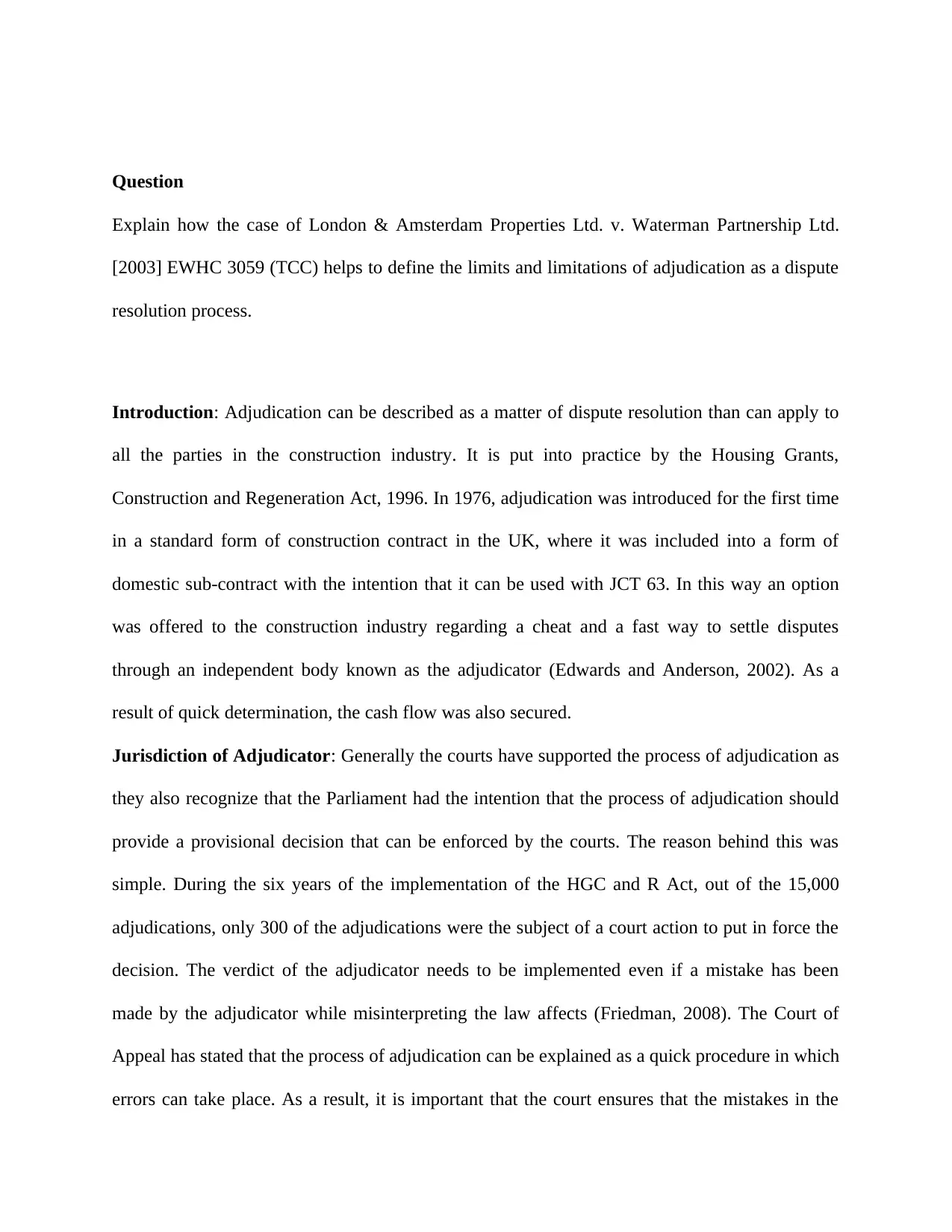
Question
Explain how the case of London & Amsterdam Properties Ltd. v. Waterman Partnership Ltd.
[2003] EWHC 3059 (TCC) helps to define the limits and limitations of adjudication as a dispute
resolution process.
Introduction: Adjudication can be described as a matter of dispute resolution than can apply to
all the parties in the construction industry. It is put into practice by the Housing Grants,
Construction and Regeneration Act, 1996. In 1976, adjudication was introduced for the first time
in a standard form of construction contract in the UK, where it was included into a form of
domestic sub-contract with the intention that it can be used with JCT 63. In this way an option
was offered to the construction industry regarding a cheat and a fast way to settle disputes
through an independent body known as the adjudicator (Edwards and Anderson, 2002). As a
result of quick determination, the cash flow was also secured.
Jurisdiction of Adjudicator: Generally the courts have supported the process of adjudication as
they also recognize that the Parliament had the intention that the process of adjudication should
provide a provisional decision that can be enforced by the courts. The reason behind this was
simple. During the six years of the implementation of the HGC and R Act, out of the 15,000
adjudications, only 300 of the adjudications were the subject of a court action to put in force the
decision. The verdict of the adjudicator needs to be implemented even if a mistake has been
made by the adjudicator while misinterpreting the law affects (Friedman, 2008). The Court of
Appeal has stated that the process of adjudication can be explained as a quick procedure in which
errors can take place. As a result, it is important that the court ensures that the mistakes in the
Explain how the case of London & Amsterdam Properties Ltd. v. Waterman Partnership Ltd.
[2003] EWHC 3059 (TCC) helps to define the limits and limitations of adjudication as a dispute
resolution process.
Introduction: Adjudication can be described as a matter of dispute resolution than can apply to
all the parties in the construction industry. It is put into practice by the Housing Grants,
Construction and Regeneration Act, 1996. In 1976, adjudication was introduced for the first time
in a standard form of construction contract in the UK, where it was included into a form of
domestic sub-contract with the intention that it can be used with JCT 63. In this way an option
was offered to the construction industry regarding a cheat and a fast way to settle disputes
through an independent body known as the adjudicator (Edwards and Anderson, 2002). As a
result of quick determination, the cash flow was also secured.
Jurisdiction of Adjudicator: Generally the courts have supported the process of adjudication as
they also recognize that the Parliament had the intention that the process of adjudication should
provide a provisional decision that can be enforced by the courts. The reason behind this was
simple. During the six years of the implementation of the HGC and R Act, out of the 15,000
adjudications, only 300 of the adjudications were the subject of a court action to put in force the
decision. The verdict of the adjudicator needs to be implemented even if a mistake has been
made by the adjudicator while misinterpreting the law affects (Friedman, 2008). The Court of
Appeal has stated that the process of adjudication can be explained as a quick procedure in which
errors can take place. As a result, it is important that the court ensures that the mistakes in the
Paraphrase This Document
Need a fresh take? Get an instant paraphrase of this document with our AI Paraphraser
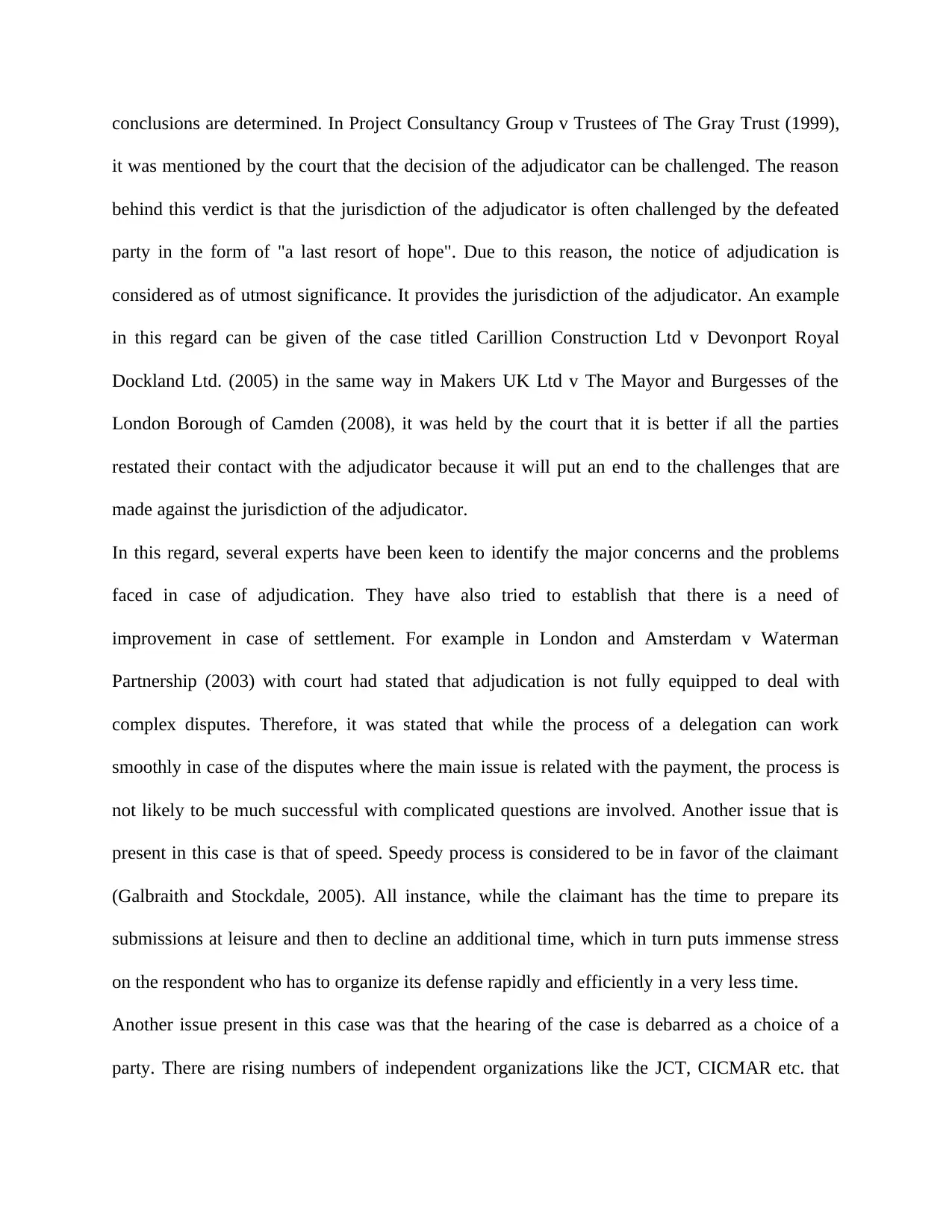
conclusions are determined. In Project Consultancy Group v Trustees of The Gray Trust (1999),
it was mentioned by the court that the decision of the adjudicator can be challenged. The reason
behind this verdict is that the jurisdiction of the adjudicator is often challenged by the defeated
party in the form of "a last resort of hope". Due to this reason, the notice of adjudication is
considered as of utmost significance. It provides the jurisdiction of the adjudicator. An example
in this regard can be given of the case titled Carillion Construction Ltd v Devonport Royal
Dockland Ltd. (2005) in the same way in Makers UK Ltd v The Mayor and Burgesses of the
London Borough of Camden (2008), it was held by the court that it is better if all the parties
restated their contact with the adjudicator because it will put an end to the challenges that are
made against the jurisdiction of the adjudicator.
In this regard, several experts have been keen to identify the major concerns and the problems
faced in case of adjudication. They have also tried to establish that there is a need of
improvement in case of settlement. For example in London and Amsterdam v Waterman
Partnership (2003) with court had stated that adjudication is not fully equipped to deal with
complex disputes. Therefore, it was stated that while the process of a delegation can work
smoothly in case of the disputes where the main issue is related with the payment, the process is
not likely to be much successful with complicated questions are involved. Another issue that is
present in this case is that of speed. Speedy process is considered to be in favor of the claimant
(Galbraith and Stockdale, 2005). All instance, while the claimant has the time to prepare its
submissions at leisure and then to decline an additional time, which in turn puts immense stress
on the respondent who has to organize its defense rapidly and efficiently in a very less time.
Another issue present in this case was that the hearing of the case is debarred as a choice of a
party. There are rising numbers of independent organizations like the JCT, CICMAR etc. that
it was mentioned by the court that the decision of the adjudicator can be challenged. The reason
behind this verdict is that the jurisdiction of the adjudicator is often challenged by the defeated
party in the form of "a last resort of hope". Due to this reason, the notice of adjudication is
considered as of utmost significance. It provides the jurisdiction of the adjudicator. An example
in this regard can be given of the case titled Carillion Construction Ltd v Devonport Royal
Dockland Ltd. (2005) in the same way in Makers UK Ltd v The Mayor and Burgesses of the
London Borough of Camden (2008), it was held by the court that it is better if all the parties
restated their contact with the adjudicator because it will put an end to the challenges that are
made against the jurisdiction of the adjudicator.
In this regard, several experts have been keen to identify the major concerns and the problems
faced in case of adjudication. They have also tried to establish that there is a need of
improvement in case of settlement. For example in London and Amsterdam v Waterman
Partnership (2003) with court had stated that adjudication is not fully equipped to deal with
complex disputes. Therefore, it was stated that while the process of a delegation can work
smoothly in case of the disputes where the main issue is related with the payment, the process is
not likely to be much successful with complicated questions are involved. Another issue that is
present in this case is that of speed. Speedy process is considered to be in favor of the claimant
(Galbraith and Stockdale, 2005). All instance, while the claimant has the time to prepare its
submissions at leisure and then to decline an additional time, which in turn puts immense stress
on the respondent who has to organize its defense rapidly and efficiently in a very less time.
Another issue present in this case was that the hearing of the case is debarred as a choice of a
party. There are rising numbers of independent organizations like the JCT, CICMAR etc. that
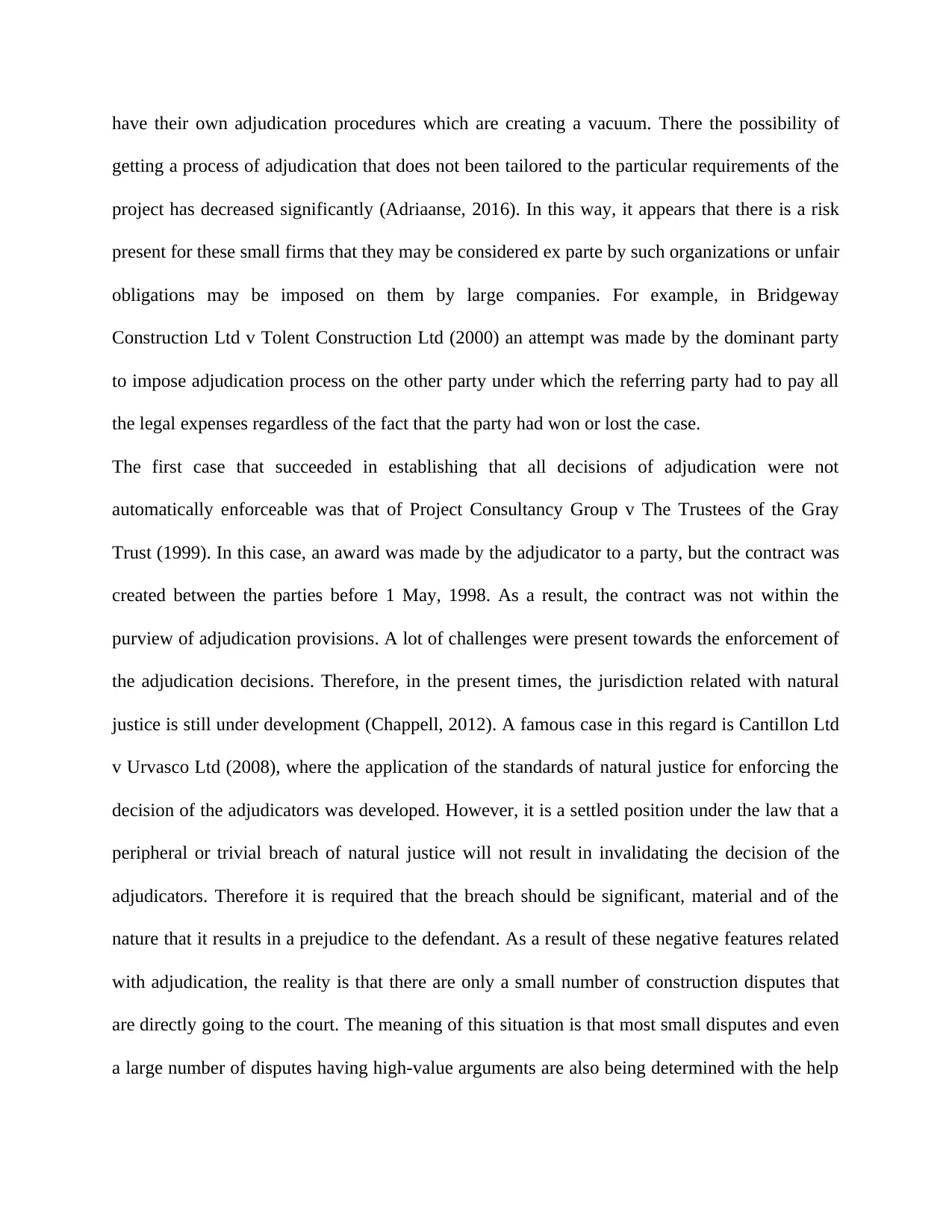
have their own adjudication procedures which are creating a vacuum. There the possibility of
getting a process of adjudication that does not been tailored to the particular requirements of the
project has decreased significantly (Adriaanse, 2016). In this way, it appears that there is a risk
present for these small firms that they may be considered ex parte by such organizations or unfair
obligations may be imposed on them by large companies. For example, in Bridgeway
Construction Ltd v Tolent Construction Ltd (2000) an attempt was made by the dominant party
to impose adjudication process on the other party under which the referring party had to pay all
the legal expenses regardless of the fact that the party had won or lost the case.
The first case that succeeded in establishing that all decisions of adjudication were not
automatically enforceable was that of Project Consultancy Group v The Trustees of the Gray
Trust (1999). In this case, an award was made by the adjudicator to a party, but the contract was
created between the parties before 1 May, 1998. As a result, the contract was not within the
purview of adjudication provisions. A lot of challenges were present towards the enforcement of
the adjudication decisions. Therefore, in the present times, the jurisdiction related with natural
justice is still under development (Chappell, 2012). A famous case in this regard is Cantillon Ltd
v Urvasco Ltd (2008), where the application of the standards of natural justice for enforcing the
decision of the adjudicators was developed. However, it is a settled position under the law that a
peripheral or trivial breach of natural justice will not result in invalidating the decision of the
adjudicators. Therefore it is required that the breach should be significant, material and of the
nature that it results in a prejudice to the defendant. As a result of these negative features related
with adjudication, the reality is that there are only a small number of construction disputes that
are directly going to the court. The meaning of this situation is that most small disputes and even
a large number of disputes having high-value arguments are also being determined with the help
getting a process of adjudication that does not been tailored to the particular requirements of the
project has decreased significantly (Adriaanse, 2016). In this way, it appears that there is a risk
present for these small firms that they may be considered ex parte by such organizations or unfair
obligations may be imposed on them by large companies. For example, in Bridgeway
Construction Ltd v Tolent Construction Ltd (2000) an attempt was made by the dominant party
to impose adjudication process on the other party under which the referring party had to pay all
the legal expenses regardless of the fact that the party had won or lost the case.
The first case that succeeded in establishing that all decisions of adjudication were not
automatically enforceable was that of Project Consultancy Group v The Trustees of the Gray
Trust (1999). In this case, an award was made by the adjudicator to a party, but the contract was
created between the parties before 1 May, 1998. As a result, the contract was not within the
purview of adjudication provisions. A lot of challenges were present towards the enforcement of
the adjudication decisions. Therefore, in the present times, the jurisdiction related with natural
justice is still under development (Chappell, 2012). A famous case in this regard is Cantillon Ltd
v Urvasco Ltd (2008), where the application of the standards of natural justice for enforcing the
decision of the adjudicators was developed. However, it is a settled position under the law that a
peripheral or trivial breach of natural justice will not result in invalidating the decision of the
adjudicators. Therefore it is required that the breach should be significant, material and of the
nature that it results in a prejudice to the defendant. As a result of these negative features related
with adjudication, the reality is that there are only a small number of construction disputes that
are directly going to the court. The meaning of this situation is that most small disputes and even
a large number of disputes having high-value arguments are also being determined with the help
⊘ This is a preview!⊘
Do you want full access?
Subscribe today to unlock all pages.

Trusted by 1+ million students worldwide
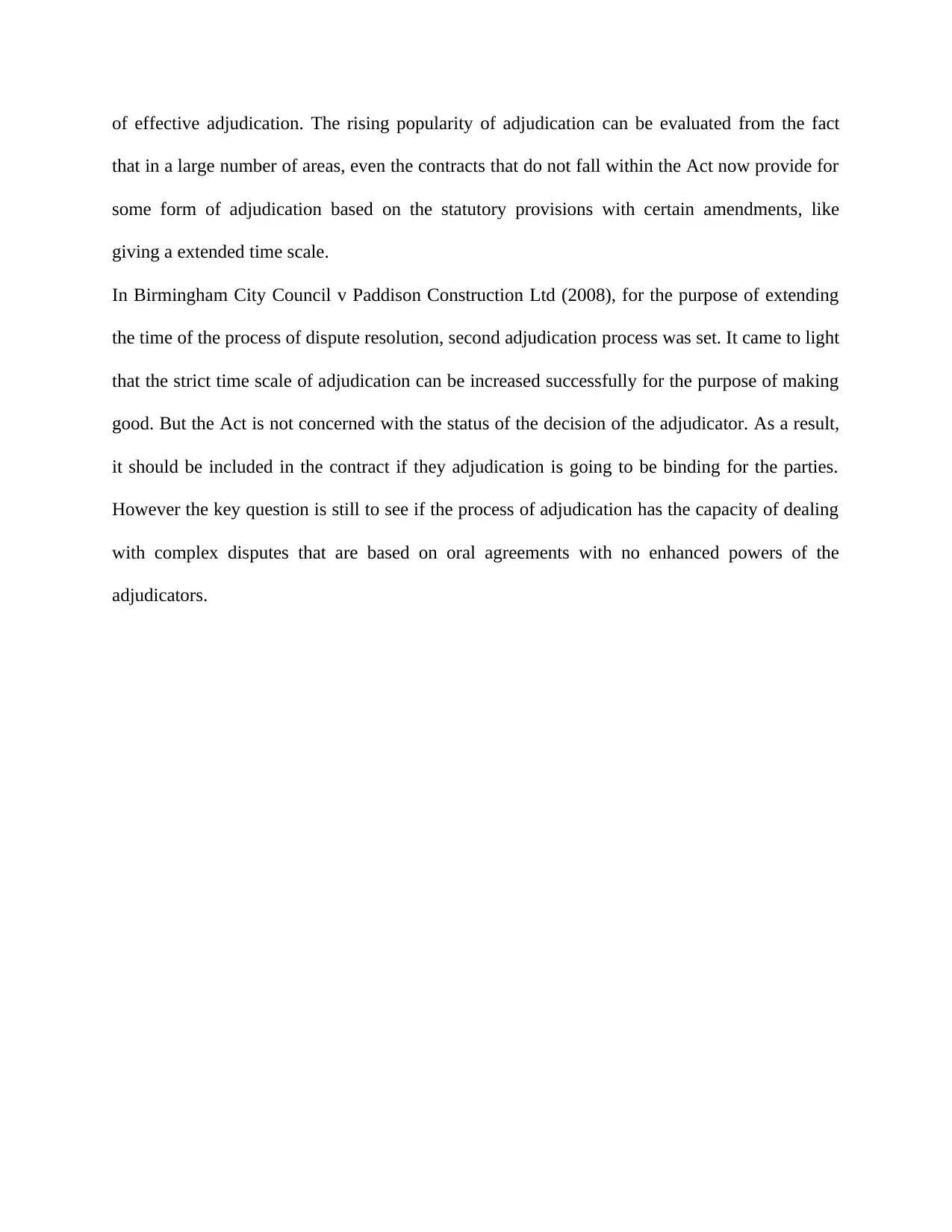
of effective adjudication. The rising popularity of adjudication can be evaluated from the fact
that in a large number of areas, even the contracts that do not fall within the Act now provide for
some form of adjudication based on the statutory provisions with certain amendments, like
giving a extended time scale.
In Birmingham City Council v Paddison Construction Ltd (2008), for the purpose of extending
the time of the process of dispute resolution, second adjudication process was set. It came to light
that the strict time scale of adjudication can be increased successfully for the purpose of making
good. But the Act is not concerned with the status of the decision of the adjudicator. As a result,
it should be included in the contract if they adjudication is going to be binding for the parties.
However the key question is still to see if the process of adjudication has the capacity of dealing
with complex disputes that are based on oral agreements with no enhanced powers of the
adjudicators.
that in a large number of areas, even the contracts that do not fall within the Act now provide for
some form of adjudication based on the statutory provisions with certain amendments, like
giving a extended time scale.
In Birmingham City Council v Paddison Construction Ltd (2008), for the purpose of extending
the time of the process of dispute resolution, second adjudication process was set. It came to light
that the strict time scale of adjudication can be increased successfully for the purpose of making
good. But the Act is not concerned with the status of the decision of the adjudicator. As a result,
it should be included in the contract if they adjudication is going to be binding for the parties.
However the key question is still to see if the process of adjudication has the capacity of dealing
with complex disputes that are based on oral agreements with no enhanced powers of the
adjudicators.
Paraphrase This Document
Need a fresh take? Get an instant paraphrase of this document with our AI Paraphraser
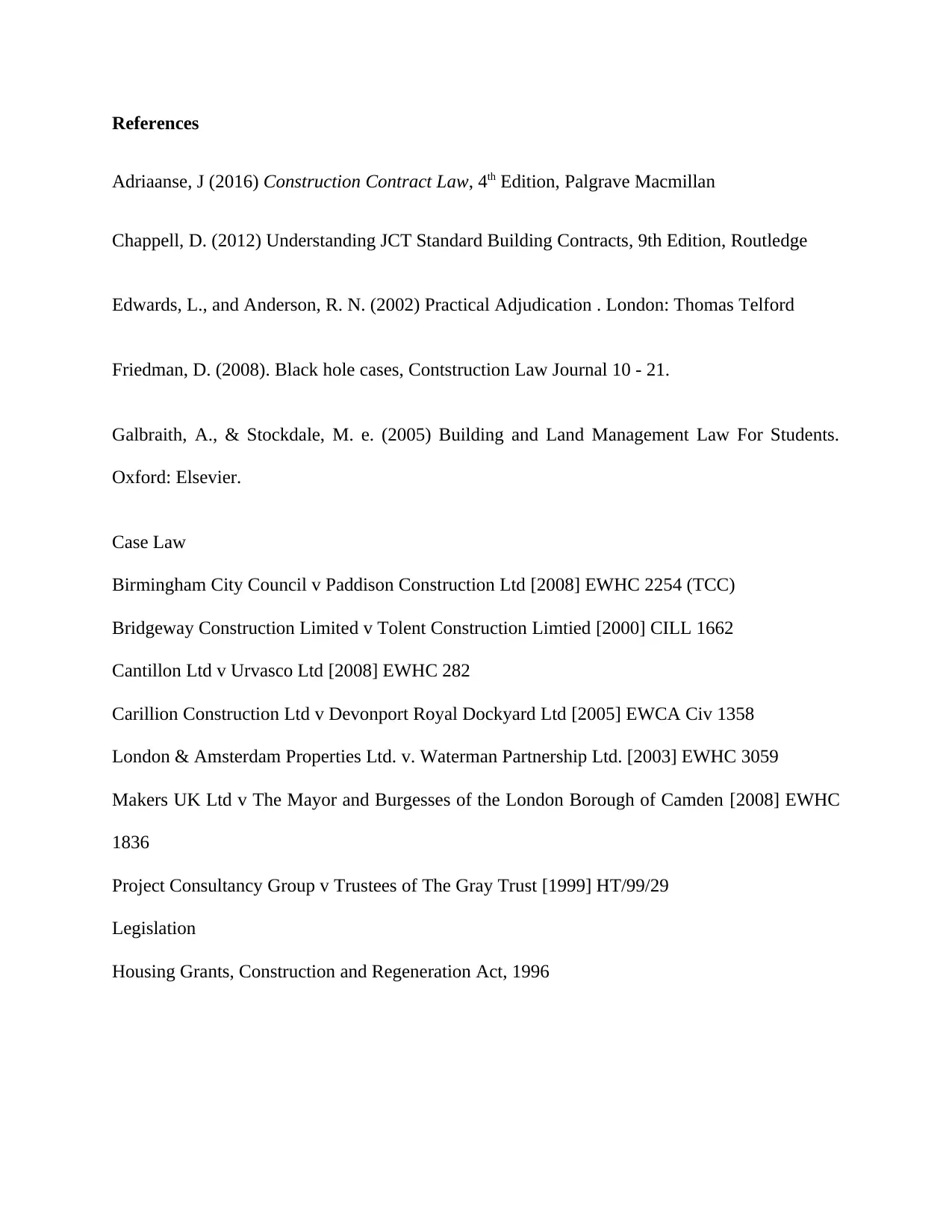
References
Adriaanse, J (2016) Construction Contract Law, 4th Edition, Palgrave Macmillan
Chappell, D. (2012) Understanding JCT Standard Building Contracts, 9th Edition, Routledge
Edwards, L., and Anderson, R. N. (2002) Practical Adjudication . London: Thomas Telford
Friedman, D. (2008). Black hole cases, Contstruction Law Journal 10 - 21.
Galbraith, A., & Stockdale, M. e. (2005) Building and Land Management Law For Students.
Oxford: Elsevier.
Case Law
Birmingham City Council v Paddison Construction Ltd [2008] EWHC 2254 (TCC)
Bridgeway Construction Limited v Tolent Construction Limtied [2000] CILL 1662
Cantillon Ltd v Urvasco Ltd [2008] EWHC 282
Carillion Construction Ltd v Devonport Royal Dockyard Ltd [2005] EWCA Civ 1358
London & Amsterdam Properties Ltd. v. Waterman Partnership Ltd. [2003] EWHC 3059
Makers UK Ltd v The Mayor and Burgesses of the London Borough of Camden [2008] EWHC
1836
Project Consultancy Group v Trustees of The Gray Trust [1999] HT/99/29
Legislation
Housing Grants, Construction and Regeneration Act, 1996
Adriaanse, J (2016) Construction Contract Law, 4th Edition, Palgrave Macmillan
Chappell, D. (2012) Understanding JCT Standard Building Contracts, 9th Edition, Routledge
Edwards, L., and Anderson, R. N. (2002) Practical Adjudication . London: Thomas Telford
Friedman, D. (2008). Black hole cases, Contstruction Law Journal 10 - 21.
Galbraith, A., & Stockdale, M. e. (2005) Building and Land Management Law For Students.
Oxford: Elsevier.
Case Law
Birmingham City Council v Paddison Construction Ltd [2008] EWHC 2254 (TCC)
Bridgeway Construction Limited v Tolent Construction Limtied [2000] CILL 1662
Cantillon Ltd v Urvasco Ltd [2008] EWHC 282
Carillion Construction Ltd v Devonport Royal Dockyard Ltd [2005] EWCA Civ 1358
London & Amsterdam Properties Ltd. v. Waterman Partnership Ltd. [2003] EWHC 3059
Makers UK Ltd v The Mayor and Burgesses of the London Borough of Camden [2008] EWHC
1836
Project Consultancy Group v Trustees of The Gray Trust [1999] HT/99/29
Legislation
Housing Grants, Construction and Regeneration Act, 1996
1 out of 5
Related Documents
Your All-in-One AI-Powered Toolkit for Academic Success.
+13062052269
info@desklib.com
Available 24*7 on WhatsApp / Email
![[object Object]](/_next/static/media/star-bottom.7253800d.svg)
Unlock your academic potential
Copyright © 2020–2025 A2Z Services. All Rights Reserved. Developed and managed by ZUCOL.




